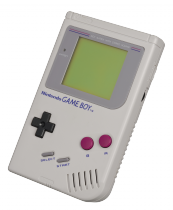
Ambitiously Technical Game Boy Games
For every platform, there are games that push the boundaries on what a system can do and the humble Game Boy was no exception. The whole line had a surprising number of games that managed to squeeze out visuals you wouldn’t necessarily have expected, so here is a sample that impressed.

Race Drivin’
Atari Games (1993)
The Argonaut (of Starglider and Star Fox fame) developed port of Race Drivin’ for the original Game Boy is remarkable in how it managed to throw filled polygons around the screen at all. The performance wasn’t great, getting up to almost double-digit framerates but that doesn’t negate how impressive a technical feat this was.
Unfortunately, the game itself isn’t very fun, partially because of the framerate (to be fair, most of the ports at the time ran poorly) but the checkpoint based courses just aren’t very interesting.

X
Nintendo (1992)
Another Argonaut affair, this time using a simpler visual approach with non-filled polygons. X saw you piloting a space tank completing missions as you defend Earth from an alien menace. Each mission took place in vast spaces as you took on enemy patrols, restored power to facilities and navigated underground tunnels.
Sadly this Game Boy title never came to the West, leaving this quirky, impressive game in Japan. It was planned to make the trip, having the working title of “Lunar Chase” but unfortunately, it wasn’t to be.

Wacky Races
Infogrames (2000)
A pair of names that come up repeatedly when researching games that push systems to their limits are those of the French duo, Fernando Velez and Guillaume Dubail who would later become VD-dev. They worked on a plethora of games for Infogrames with a specific focus on the Game Boy and DS range of systems and could wring some miraculous things out of these machines.
Wacky Races is a kart racer that plays how you’d expect, but visually the game is a treat with sublimely smooth scrolling and impressively texture-mapped roads. This is something that you rarely, if ever, saw on the humble Game Boy Color, that it runs so slickly is incredible.
It’s also a pretty fun game with a nice variety of tracks and a whole lot of charm. The racing itself has a lovely old-school Lotus Esprit Turbo Challenge feel which somehow feels wholly appropriate.

Shantae
Capcom (2002)
The infamous hair-whipping half-genie made her debut in this WayForward developed classic on the Game Boy Color. It stood out due to the gorgeous art direction but the animation, in particular, shines thanks to the abundance of frames making it super smooth and full of character.
It helps that the game itself is a stunning platformer that is just as much fun to play today as any top-tier Mario or Sonic title. There isn’t really another game as accomplished as this on the Game Boy and its visual flourishes still impress.

Smashing Drive
Namco (2004)
The Game Boy Advance was primarily known as a 2D powerhouse, bringing enhanced SNES quality visuals into the palm of your hands, so seeing it produce competent 3D graphics seemed like sorcery.
This port of the taxi-themed point to point racer is better than it has any right to be. Impressive texture-mapped models and environments that move at a pretty consistent and playable frame rate belie the machine it’s running on. As a technical showpiece, it’s very impressive, featuring large, detailed and destructible environments as you tear through the city to your destination.

Driv3r
Infogrames (2005)
While Smashing Drive is impressive, nothing quite compares to the miraculous feat that is Driv3r on the GBA. This is another Velez and Dubail affair which crams far more of its console cousin into the handheld than is reasonable to expect.
The game manages to fitin the entirety of both Miami and Nice into the cartridge, only having to sacrifice Istanbul. The story is also a more abridged version of what was in its console brother but like most of the games in this article, that it’s here at all is amazing.
Visually the game runs at an impressive clip considering the open world nature of the game with its mix of 3D environments and 2D sprites for vehicles and characters. Some shortcuts have been taken, with extremely simple AI for enemies and simplified mission objectives but by and large, this is like having the original console game in your hands.
So there you have it, a look at a small handful of the technical wonders that Nintendo’s handhelds are home to. Developers managed to squeeze a whole lot out of machines that definitely weren’t cutting edge at the time. Hopefully seeing these will encourage you to examine their libraries a bit closer and find some hidden gems.







COMMENTS